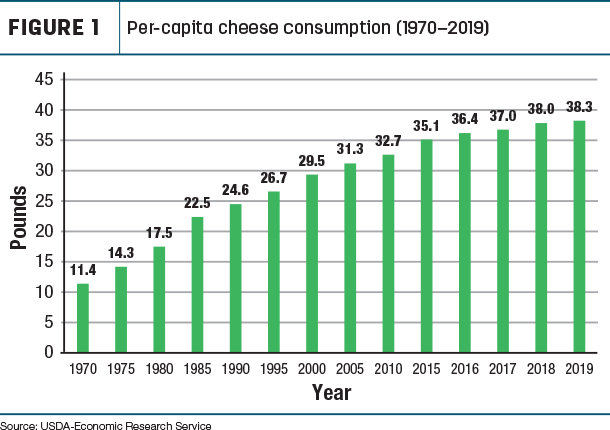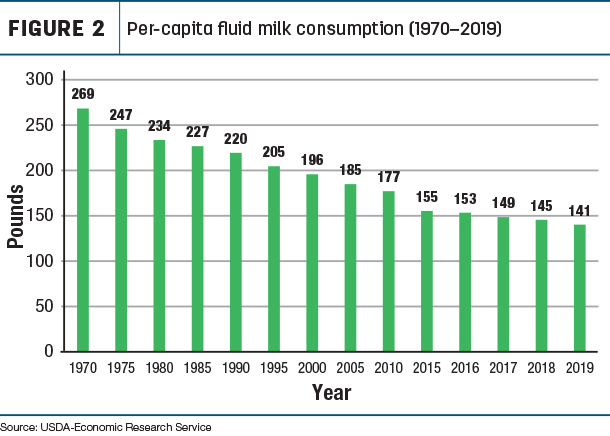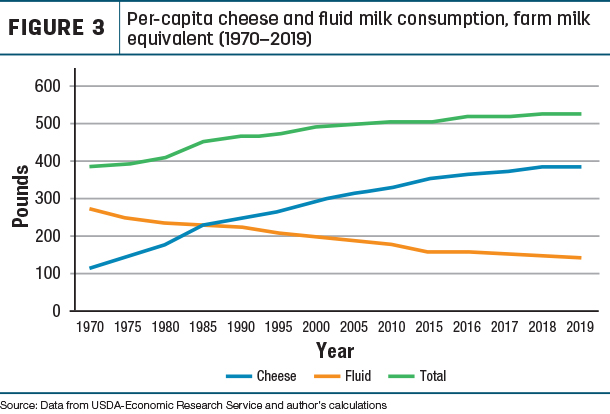(See Figure 1) Over the past 50 years, cheese consumption has tripled.

Equally impressive is the steady upward movement in cheese per capita growth. Since 1970, there are only two years, 1988 and 2008, in which per-capita consumption was lower than the previous year.
From 1970 to 2019, the U.S. population increased from 205 million to 328 million people. More people, and people eating more cheese each year, makes the growth in cheese consumption more impressive. Total domestic cheese utilization increased over 10 billion pounds from 1970 to 2019 (2.3 to 12.6 billion pounds). Last year, it took about 60% of the nation’s milk production to meet cheese demand; back in 1950 it was only 20%.
Digging into the cheese numbers shows mozzarella and other Italian cheeses fueling much of the growing cheese demand. Back in 1970, Italian cheese per-capita consumption was only about 2 pounds. American-style cheese, primarily cheddar, was the main cheese variety. Today, Italian cheese per capita is almost 16 pounds, slightly higher than American cheese. Why? Pizza. I remember I did not eat my first pizza until the early 1970s, and we had to drive over 30 miles to get it. Today, there are pizza shops all over, plus many options for home delivery.
Now turning to fluid milk and the less impressive numbers. (See Figure 2) Per-capita fluid milk consumption declined from 269 pounds in 1970 to only 141 pounds last year.

Converting to gallons, the drop is from 31.2 gallons in 1970 to 16.4 gallons in 2019.
One may think population growth would help maintain total fluid consumption. Unfortunately, this is not the case due to the large per-capita decline. In 1970 total fluid sales were 60.4 billion pounds and utilized about 50 percent of the nation’s milk production. Last year, it was only 46.4 billion pounds. Fluid milk is back where cheese was in 1970, using only a little over 20 percent of the nation’s milk production.
There are two positive trends in fluid consumption. The first is whole milk. Since 2015, per-capita consumption of whole milk increased from 45 pounds to 49 pounds in 2019. Granted, it is well below the 213 pounds back in 1970, but at least it is going up. The second trend is flavored milk. Flavored milk sales more than doubled from 1988 to 2019, from 2.1 billion to 4.5 billion pounds With improved whole and flavored milk sales, could consumers be telling us they prefer milk with more taste, especially compared to skim and reduced fat milk, which consumers continue to drink less of each year?
There are many reasons marketing experts give for increased cheese and decreased fluid consumption. Let me share three of my reasons, which are: demographics, restaurants and innovation.
1. Demographics. Prior to the coronavirus pandemic, more and more meals were eaten away from home, including breakfast, and not in the form of the traditional bowl of cereal with milk. A McDonald’s Egg McMuffin has cheese, but it is not often washed down with a large glass of milk. The U.S. population is aging, and there are fewer children per household. Generally, people drink less milk as they age.
2. Restaurants. Another reason is the growth of fast-food, casual restaurants and more pizza establishments. These restaurants utilize a lot of cheese and relatively little fluid milk. These restaurants make food more convenient, quick and easy, through drive-through pick-up windows and home delivery. The days of the milkman delivering fresh fluid directly to homes may be a thing of the past for most neighborhoods. However, almost any hour of the day, you can have a pizza delivered to your home – a pizza that utilizes a gallon or more of milk to make the cheese it contains.
3. Innovation. Compared to fluid milk, the cheese industry has been more innovative over the years. When I was growing up, about the only kind of cheese you could purchase was American slices, or “hoop” cheese at the country store. Today, look at all the varieties of cheese in a grocery store in various packages from chucks to sliced (thick or thin) to shreds. Plus, cheese has more brand recognition than fluid milk, which I think supports sales. Granted, we are seeing more innovation in fluid milk, but it still lags behind cheese. Unfortunately, many consider fluid milk a commodity, bought and sold mainly on price, which hampers innovation.
Yes, cheese demand continues to increase and fluid milk declines. The good news, especially for dairy farmers, is total demand for the volume of farm milk needed to produce cheese and fluid milk has increased. Let me explain. It takes about 10 pounds of farm milk to make a pound of cheese. For simplicity’s sake, a pound of farm milk produces a pound of processed fluid milk. (In actuality it takes a little more than a pound of farm milk due to standardizing to the needed fat percentage, but I am keeping it simple.)
Back in 1970, it took 114 pounds of farm milk to produce the per-capita cheese consumption of 11.4 pounds (11.4 pounds times 10). Adding the 114 pounds to the fluid per capita of 269 pounds results in a total of 383 pounds. In other words, it took 383 pounds of farm milk, or the term I use, per-capita farm milk equivalent, to produce the cheese and fluid milk consumed by the average person in 1970.
Now we turn to 2019. Per- capita cheese consumption was 38.3 pounds – 383 pounds of farm milk were needed to produce this amount of cheese. Fluid milk per-capita consumption was 141 pounds. Adding the two together equals 524 pounds of per-capita farm milk equivalent. From 1970 to 2019, consumers increased their use of farm milk, in the form of cheese and fluid milk, by 141 pounds (see Figure 3).

It is interesting to note, in cheese consumption alone, consumers are utilizing the same volume of farm milk in 2019 as they were in 1970 for both cheese and fluid.
Yes, consumers are “eating” more and “drinking” fewer dairy products. All current signs point to this continuing for coming years. The good news for dairy farmers is the total volume of farm milk needed to meet the combined per-capita demand for both cheese and fluid milk is growing and should continue to do so for the coming years. ![]()
Calvin Covington is a retired dairy cooperative CEO and now does some farming, consulting, writing, and public speaking.

-
Calvin Covington
- Retired Dairy Co-op Executive
- Email Calvin Covington







